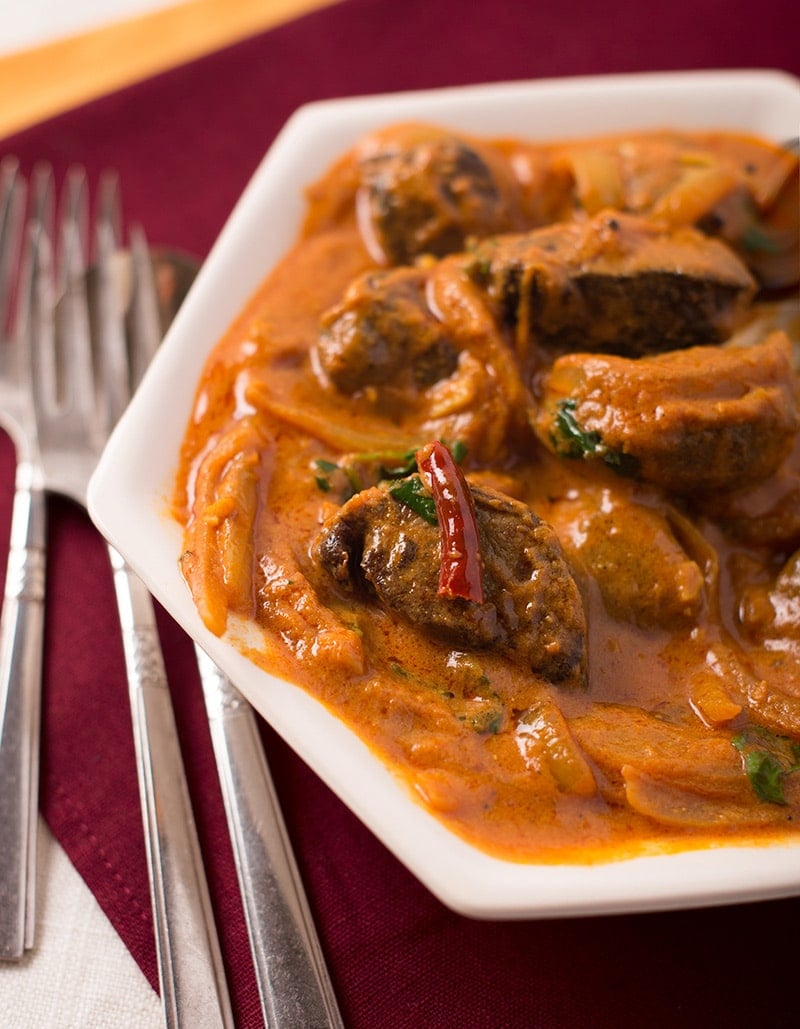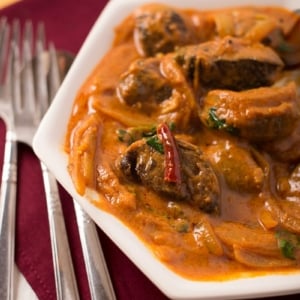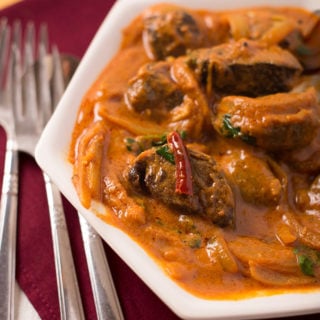As an Amazon Associate I earn from qualifying purchases.

Basically this is a Madras chicken curry turned into a rabbit curry. I have not yet found a curry designed for rabbit in Indian cuisine, but I am betting it exists. So in that vein, if you don’t happen to have rabbits lying around your fridge, use chicken or any other white meat.
There is an ulterior motive at work here, too, however. I have a lot to learn about Indian food, and making curries is a good way to start that journey. This is one of my first forays into the subcontinent’s cooking (the other being a Goan crab curry), and while I like curry just fine, it is still a cuisine foreign to me.
As for this recipe, it’s fun — and since I used a store-bought curry paste, super easy. You can literally have this bad boy done in an hour.
Rabbit or Hare Curry
Ingredients
- 1/4 cup ghee, clarified butter, or vegetable oil
- 2 pounds hare or rabbit meat, cut off the bone and into chunks
- Salt
- 2 cups yellow or white onion, sliced root to tip
- 2 tablespoons minced ginger
- 2 tablespoons minced garlic
- A 14-ounce can of tomato puree
- 1 cup plain yogurt, Greek style is best
- 2 cups water
- 2 bay leaves
- 1 heaping teaspoon turmeric
- 1/4 cup Madras curry paste, or 2 tablespoons Madras curry powder
- 1 tablespoon Garam Masala
- 1/4 cup chopped cilantro for garnish
Instructions
- Heat the clarified butter in a wide pot (like a sauce pot or high-sided frying pan with a lid) over medium-high heat. Pat the hare pieces dry with paper towels and brown them well. Salt the meat as it cooks. Remove to a bowl once browned.
- Add the onion and saute until it begins to brown at the edges, about 5 minutes. Add the ginger and garlic and cook another minute.
- Return the meat to the pot and add the tomato puree, water, bay leaves, turmeric and Madras curry paste. Stir in the yogurt and bring to a gentle simmer. Add salt to taste and simmer for 30 minutes.
- Finish by stirring in the Garam Masala and the cilantro. Serve over rice.
Notes
Nutrition
Nutrition information is automatically calculated, so should only be used as an approximation.






This is a brilliant dish. I ended up using a mix of meats as I was light on rabbit and it worked just fine. better than any simmer sauce. Great for any weeknight meal.
I made this twice, and loved it both times. But the second time with coconut milk instead of yogurt – I prefer the coconut. Hank, is there a different time /temp/prep tip for coconut milk vs yogurt? Thanks
Thanks for this recipe. I replaced the tomato puree with coconut milk, and added a ghost pepper. DELICIOUS!!
Hello!
The recipe sounds really good, and the photograph is beautiful. I like to make my own garam masala, rather than use the store bought powder. You can tell the difference from the aroma itself. Also, it was only after I came to the US that I heard of “curry powder”. I am sure it is used in some dishes, but definitely not all. And I assure you, all Indian dishes are not stews with rice though we do like some gravy to things.
Since you asked, here’s are a couple of things you can do differently on your own recipe
I like to grind the garam masala spices (cardamom, cumin, peppercorn, cinnamon etc) and put them into the oil before the onions. The oil carries the flavours to the taste buds.
I also like to put in the turmeric and a little salt as soon as the onions are slightly done.
Instead of browning the meat before hand, you could put in the meat once the onion, ginger n garlic are fried. coat and fry with the “masala”.
For this dish I would use either the tomato or the yogurt, not both (this doesn’t mean you cant use both). I’d add it once the meat is fried in the masala.
I’d skip the curry powder, and add green chiles, chopped. The amount would depend on how much heat you like in your dish.
Do let me know if you like it with the changes, should you decide to try it out. On a side note, “Hare Krishna” is actually a mantra, chanted by many but mainly the Vaishnavs (followers of Vishnu). They are staunch vegetarians, just so you know 😉
Just discovered this site. Wow. I was searching for some small game recipes and found everything I need in one place. I’m in Alaska, so lots of snowshoe hares, which I never knew what to do with. I discovered quick that Grandma’s PA cottontail recipes don’t work, at all. Then, I found the Hare Krishna recipe. I’ve got Hunt Gather Cook coming in the mail. Can’t wait.
An Indian food book recommendation. The New Curry Bible by Pat Chapman. We lived in London for 2 years and I got addicted to Indian food. No good options in Alaska. I had to learn to cook my own, so I started buying books. The New Curry Bible is the best of the dozen+ I have.
We love indian food. One thing we do is add indian flavors to our cooking instead of cooking an actual recipe. Try some garam masala with your meat instead of salt and pepper. Use diced chilies and rose water. Even find a good curry powder. You may find that you like the flavors better. We make curried eggs which are hard boiled eggs cooked with curry powder and chilies. It’s a bit more soupy than other indian inspired foods since the eggs float in a sauce.
I’ve made rose scented chicken which would be awesome with any game meat.
I got a kick out of the title, as well as your title for oyster, oyster, oyster! I really enjoy Indian food although I tend to be a spice wuss which often limits my choices. I love a good korma and definitely get cravings for Indian food. Unfortunately, I haven’t found a good Indian restaurant in my part of Sweden, so I too am interested in being better at preparing Indian food. Good luck to us both in our pursuit.
This looks really good. But I’d say apart from getting a good cookbook (I learned from Julie Sahni) go into an Indian Grocery store and start buying spices. They have to be toasted and ground at the last minute. And I think once you get hooked on certain flavor combinations, you crave them. The same way people learn about Mexican food, and how it is way beyond the combo plate, the exact same is true of Indian. And you know these two cuisines are long lost distant cousins. At least the Medieval Persian influence runs in one direction to Mughal India and the other to Medieval Spain and Mexico. Think of this the same way: spice, heat, aroma, sourness, savory, sweet all balanced. Ken
Just braised up 3 wild rabbits for a traditional stew – I concentrate down the broth & we eat it with doughboys here on the east coast. However, after seeing your post today, I’m setting one aside to do up “Hare Krishna” style for sure.
Your blog has been a godsend for a city girl whose husband loves game & drags all manner of things home for me to cook!
I too got a chuckle at the title. It looks really wonderful. I’d have to agree with the other posters that the appeal is the layers of flavors, tempering the mustard seeds, the slow melting of onion, ginger and garlic in ghee, the spices perfuming the kitchen – you get the picture. Nicely done!
The thing to me about Indian food is the complex interaction of spices within a dish and the variety of flavors and textures you get with a whole meal. it’s not just glop on rice–make a simple aloo gobi https://www.stevechatterton.com/bend-it-like-beckham-aloo-ghobi.html
(yeah, straight from a movie, but I’ve made this to rave reviews) and make your own garam masala to use in it. Your kitchen smells amazing, you get to explore each spice individually and in combination AND you have a killer secret ingredient to add to just about anything!
Then serve with fluffy basmati rice, warm breads, and at LEAST two condiments. Holy moly the side dishes and condiments with these meals–yogurt sauces and chutneys are a good place to start.
Ummmm…it seems to be a real religion…they are vegetarian…
Check out “The Hare Krsna Cookbook: Reciped for the Satisfaction of the Supreme Personality of Godhead” compiled by Krsna Devi Dasi and Sama Devi Dasi (pub: The Bhaktivedanta Book Trust,1973).
“Readers interested in the subject matter of this book are invited by the International Society for Krishna Consciousness to correspond with its Secretary: International Society for Krishna Consciousness; 3959 Landmark Street; Culver City, California 90230”
I found the book in a used book store long after the the “monks” disappeared from the airports.
That aside…love your blog and have been on your email list for years.
I laughed out loud when I saw the title of this post – Holli’s photo was just exactly what I expected for this very saffron-colored hare dish. I must say that my first taste of Indian food, in some hole-in-the-wall restaurant somewhere in a back alley of San Fran many years ago was what first turned me on to cooking. The fragrant layers of aromas and tastes was entirely new to me and I loved it. Although I ordinarily don’t like cookbooks without photos, Julie Sahni’s “Classic Indian Cooking” is a major exception. You can literally smell and taste the dishes without stimulating photos, her descriptions are so good! Also, she shows that Indian food is much much more than “stews with rice.” What I also like is that she provides suggestions for what goes with what, so that all the possible layers of tastes are covered in a meal. Indian food is a sensual experience and I think it lends itself quite well to hunted and gathered foods. Have fun!! And, of course let us in on your experiences!
Thanks for sharing. I was given a book called “50 Great Curries of India” (Camellia Panjabi) and have taken to cooking curry as often as I can.
Will be trying this which sounds both easy and yummy
Hank, you might try the cookbook 660 Curries, by Raghavan Iyer. Most of the recipes are fairly involved productions, and many use ingredients you might not get out of a jar. Lots of layering of flavors and an experienced cook can quickly figure out how to add, subtract, and adjust the recipes.
Also, most Indian restaurants here are North Indian, but South Indian food is quite different.
I think I understand what you are saying about Indian food and I can see how you wouldn’t think much of it if you only had it from a restaurant or a jar. For me Indian food is about the whole sensory experience that comes with the layering of temperatures, textures and spices. When I make curry at home, I’ll admit I am guilty of making the same Tikka Masala often, but I love it. As I am making it I consciously add only one spice or ingredient at a time, so that it builds the senses. Although I never tell anyone that is what I am doing, anyone who is in the house always says “Wow, it just keeps smelling better in here”. I purposely make mine a little spicier than I would normally eat a dish so I can add a nice cooling raita to bring the temperature down. I have a shallot and green apple one that is a favorite. When you combine the hot and spicy curry with the cold from the refrigerator raita, I think that is the addiction to Indian food for me. I also love all the choices for flatbread as well.
I love the name for this and I think I will have to adapt my favorite curry recipe for Hare, although Hare Tikka Masala doesn’t have quite the ring to it!
I commend your efforts to take on new styles of cuisine. Your recipes have become very popular on my Pinterest boards as well. I’ve recently been on a similar mission myself. I’ve become very comfortable making traditional “European” dishes – Italian, Spanish, Portuguese, French… But I’ve never made much Indian, Asian, etc. I live in a neighborhood with a fantastic variety of specialty/ethnic markets – so I’m trying to broaden my horizons. I’ve even started a blog for documentation/motivation.
I look forward to following your Indian food journey – I’m sure I’ll learn a lot of great tips I can apply to my own experiments!
Best of luck to you!
I love Indian food but for some reason never thought of using game meat when I cook it. I bet those tough chunks of venison in the freezer would work perfectly in a curry cooked in the pressure cooker.
I hear you about most Indian food being a stew over rice but I don’t think that’s really the way they eat in much of India. When I was in India it seemed like rice and dahl was about the only thing on offer; the only variety being the color of the dahl.
If you’re looking for a good cookbook, try Curried Favors by Maia Kaimal Macmillan. It’s a south Indian book and has a lot of dry curries. The potato onion curry is awesome…
I groaned when I read the title of this recipe. (Then I pinned it – your recipes are becoming quite popular both in my home and on my blog.)
I only have domestic rabbit in my freezer, but I do have some venison (I’ve already made your venison massaman curry), but the name won’t be as much fun.
What was it lacking? Fragrance? Sweetness? Something with a little extra texture? Consider cardamom pods (just a few) for the former or some kind of nut (cashew, almond) for the latter. And the voice of experience here – don’t eat the cardamom pods. It’s like having a perfume bottle explode in your mouth.